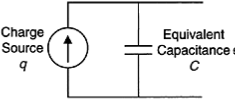SKEDSOFT
Introduction:
Some substances, such as barium titanate, single-crystal quartz, and lead zirconate-titanate (PZT) can generate an electrical charge and an associated potential difference when they are subjected to mechanical stress or strain.
Piezoelectric Sensors:
This piezoelectric effect is used in piezoelectric transducers. Direct application of the piezoelectric effect is found in pressure and strain measuring devices, touch screens of computer monitors, and a variety of microsensors. Many indirect applications also exist.
They include piezoelectric accelerometers and velocity sensors and piezoelectric torque sensors and force sensors. It is also interesting to note that piezoelectric materials deform when subjected to a potential difference (or charge or electric field). Some delicate test equipment (e.g., in vibration testing) use piezoelectric actuating elements (reverse piezoelectric action) to create fine motions.
Also, piezoelectric valves (e.g., flapper valves), with direct actuation using voltage signals, are used in pneumatic and hydraulic control applications and in ink-jet printers. Miniature stepper motors based on the reverse piezoelectric action are available.
Micro actuators based on the piezoelectric effect are found in a number of applications including hard-disk drives (HDD) and micro-electromechanical systems (MEMS).
Modern piezoelectric material include lanthanum modified PZT (or, PLZT) and piezoelectric polymeric polyvinylidene fluoride (PVDF).
The piezoelectric effect arises as a result of charge polarization in an anisotropic material (having nonsymmetric molecular structure), as a result of an applied strain.
This is a reversible effect. In particular, when an electric field is applied to the material so as to change the ionic polarization, the material will regain its original shape. Natural piezoelectric materials are by and large crystalline whereas synthetic piezoelectric materials tend to be ceramics. When the direction of the electric field and the direction of strain (or stress) are the same, we have direct sensitivity.
Other cross-sensitivities can be defined in a 6×6 matrix with reference to three orthogonal direct axes and three rotations about these axes.
Consider a piezoelectric crystal in the form of a disc with two electrodes plated on the two opposite faces. Since the crystal is a dielectric medium, this device is essentially a capacitor, which may be modeled by a capacitance C.
An equivalent circuit (Thevenin equivalent representation) can be given as well, where the capacitor is in series with an equivalent voltage source.
The impedance from the capacitor is given by

